Welcome to my guide on soil for beginners! Whether you’re new to gardening or looking to improve your green thumb skills, understanding the basics of soil is crucial for growing healthy plants in your backyard.
Factual Data: Unlocking the ground and understanding soil is essential for gardening success. Good potting soil is important for germinating seeds and growing seedlings, while a healthy garden soil allows plants to thrive. When choosing potting soil, it is important to look for qualities like good drainage, lightweight texture, and the ability to hold nutrients and moisture. Common ingredients in potting soil mixes include sphagnum peat moss, coconut coir, perlite, vermiculite, compost, and granular fertilizers.
A basic potting soil mix can be made by combining peat or coco coir with perlite or vermiculite, while a complete potting soil mix contains peat moss or coconut coir, perlite or vermiculite, compost, blood meal, bone meal, and ground limestone.
Testing the pH level of the soil is important as it determines nutrient availability, and a pH level between 6 and 7 is ideal for plant growth. To improve soil, it is recommended to add organic matter like humus, minimize the use of pesticides, and allow the soil to dry before planting. Understanding the type of soil in your garden is also crucial, as clay soil holds moisture but drains slowly, sandy soil drains quickly but lacks nutrients, and loamy soil is ideal for plant growth.
It is also important to consider the soil’s pH level and nutrient content. Adding organic matter, such as compost, aged manure, and leaf mold, can improve soil quality by providing nutrients, improving drainage, and fostering beneficial soil organisms.
Key Takeaways
- Understanding soil basics is crucial for successful gardening.
- Potting soil should have good drainage, lightweight texture, and the ability to hold nutrients and moisture.
- Common ingredients in potting soil mixes include sphagnum peat moss, coconut coir, perlite, vermiculite, compost, and granular fertilizers.
- Testing the pH level of the soil helps determine nutrient availability for plants.
- Adding organic matter, like compost and aged manure, can improve soil quality and foster beneficial soil organisms.
Why Soil Matters for Gardening Success
Good soil is the foundation of any successful garden. It provides the necessary nutrients, moisture, and support for plants to thrive and produce bountiful harvests. As a beginner gardener, understanding the importance of soil is crucial for your gardening success. By knowing the basics of soil composition and its role in plant growth, you can make informed decisions when choosing and preparing your garden soil.
When it comes to gardening, different plants have different soil requirements. Some prefer well-draining soil, while others thrive in moisture-retaining soil. Some plants may need more acidic soil, while others require alkaline soil. By understanding these soil preferences, you can provide the ideal growing conditions for your plants.
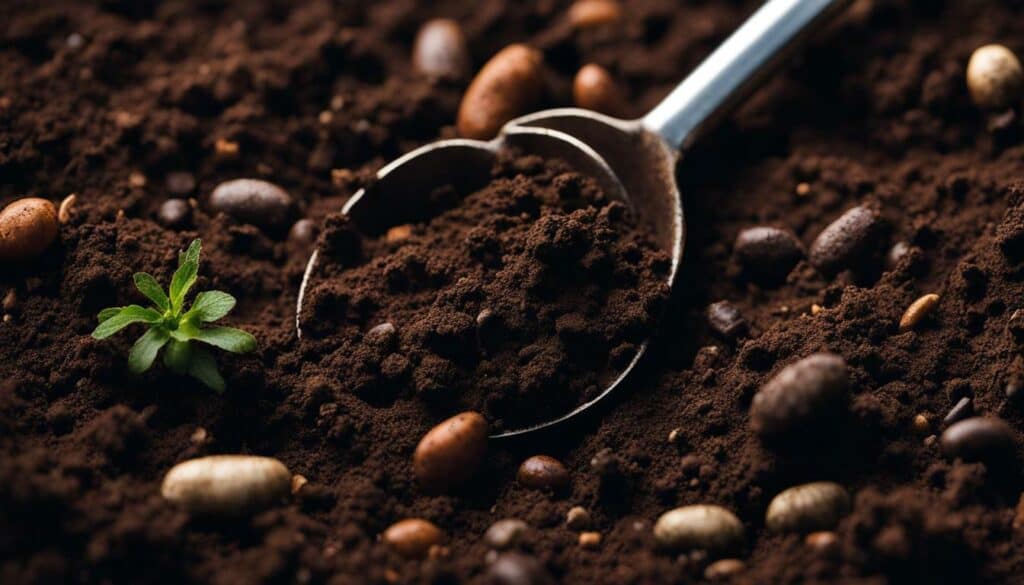
One important aspect of soil knowledge is its composition. Potting soil, commonly used in containers and raised beds, often consists of a mix of organic matter, such as sphagnum peat moss or coconut coir, and other components like perlite or vermiculite. These ingredients not only provide a lightweight texture and good drainage but also ensure that the soil can hold essential nutrients and moisture for plant roots.
In addition to understanding soil composition, it is crucial to test the pH level of your soil. pH determines nutrient availability for plants. A pH level between 6 and 7 is considered ideal for most plants. If your soil is too acidic or alkaline, you can adjust it by using amendments like ground limestone or sulfur. Testing the pH level of your soil will help you determine the appropriate amendments to create a balanced soil environment for your plants.
Why Soil Matters for Gardening Success
- Soil provides essential nutrients, moisture, and support for plants to thrive.
- Different plants have different soil requirements, including drainage, moisture retention, and pH level.
- Potting soil, commonly used in containers, should have a balanced composition of organic matter, perlite or vermiculite, and other components.
- Testing the pH level of your soil is crucial for determining nutrient availability for plants.
By developing a basic understanding of soil and its importance in gardening, you can set yourself up for success. The right soil conditions will enhance the health and productivity of your plants, ensuring a flourishing garden that you can be proud of.
| Type of Soil | Characteristics |
|---|---|
| Clay Soil | Holds moisture but drains slowly, can be compacted |
| Sandy Soil | Drains quickly but lacks nutrients, may require additional organic matter |
| Loamy Soil | Ideal for plant growth, retains moisture while providing good drainage |
Understanding the type of soil in your garden is also crucial. Clay soil tends to hold moisture but drains slowly and can become compacted, while sandy soil drains quickly but lacks essential nutrients. Loamy soil strikes a balance, offering good drainage and moisture retention, making it ideal for plant growth.
By considering the soil’s pH level, nutrient content, and type, you can create a garden environment that promotes healthy plant growth. Adding organic matter, such as compost, aged manure, and leaf mold, can improve soil quality by providing essential nutrients, improving drainage, and fostering beneficial soil organisms. Minimizing the use of pesticides and allowing the soil to dry before planting can also contribute to the overall health of your garden soil.
| Component | Role |
|---|---|
| Sphagnum Peat Moss or Coconut Coir | Provides organic matter and helps retain moisture |
| Perlite or Vermiculite | Improves drainage and adds lightweight texture |
| Compost | Enriches soil with nutrients and beneficial microorganisms |
| Blood Meal or Bone Meal | Supply slow-release nutrients for plant growth |
| Ground Limestone | Adjusts soil pH and provides calcium |
Soil knowledge is an essential tool for every beginner gardener. With a solid understanding of soil basics, composition, pH levels, and nutrient availability, you can create the ideal growing conditions for your plants. Unlock the potential of your soil and watch your garden flourish!
Key Characteristics of Potting Soil
When it comes to potting soil, not all dirt is created equal. Understanding the basics of soil composition and the different types available will help you make the right choice for your plants.
Potting soil is specially formulated to provide the ideal environment for plants to grow. It should have several key characteristics that contribute to plant health and successful gardening. Good drainage is essential to prevent waterlogged roots, as excess moisture can lead to root rot. Look for potting soil that contains ingredients like perlite or vermiculite, which help improve drainage and prevent water from stagnating.
Another important characteristic of potting soil is a lightweight texture. This allows for proper aeration and root development. Potting soil that is too compacted or heavy can restrict root growth and lead to poor plant health. Ingredients like sphagnum peat moss or coconut coir add lightness to the soil while retaining moisture.
Potting soil should also have the ability to hold nutrients and moisture. This is crucial for providing plants with the essential elements they need for growth. Look for potting soil that contains organic matter such as compost, which provides a rich source of nutrients. Additionally, ingredients like blood meal, bone meal, and ground limestone can further enhance the nutrient content of the soil.
The table below summarizes the key characteristics of potting soil:
| Characteristics | Description |
|---|---|
| Good Drainage | Prevents waterlogged roots and root rot |
| Lightweight Texture | Aerates the soil and promotes root development |
| Nutrient and Moisture Retention | Provides essential nutrients and retains moisture for plant growth |
By understanding the key characteristics of potting soil, you can choose the right type for your gardening needs. Whether you are starting seeds, growing seedlings, or maintaining mature plants, selecting the appropriate potting soil will set the foundation for healthy and thriving plants.
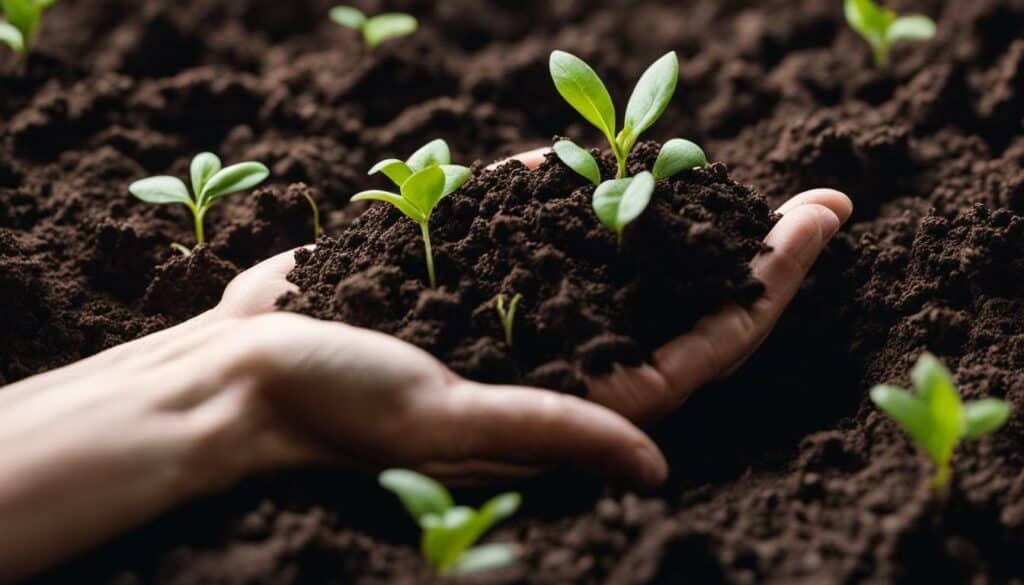
Essential Ingredients in Potting Soil
A good potting soil mix contains a combination of ingredients that provide the right balance of drainage, moisture retention, and nutrient availability for your plants. Whether you’re starting seeds or transplanting seedlings, choosing the right potting soil is crucial for their healthy growth. Here are some essential ingredients commonly found in potting soil mixes:
- Sphagnum Peat Moss: This organic material helps retain moisture and creates a light, fluffy texture in the soil.
- Coconut Coir: Similar to peat moss, coconut coir is an eco-friendly alternative that retains moisture and promotes root growth.
- Perlite: This volcanic glass is light and porous, improving drainage and preventing soil compaction.
- Vermiculite: Made from natural minerals, vermiculite helps retain moisture in the soil and improves aeration.
- Compost: Adding compost to your potting soil mix enriches it with organic matter and nutrients, promoting healthy plant growth.
- Granular Fertilizers: These slow-release fertilizers provide essential nutrients to your plants over time.
For a basic potting soil mix, you can combine peat moss or coconut coir with perlite or vermiculite. If you want a more complete mix, include additional ingredients like compost, blood meal, bone meal, and ground limestone. These additional ingredients provide a wider range of nutrients and minerals for your plants.
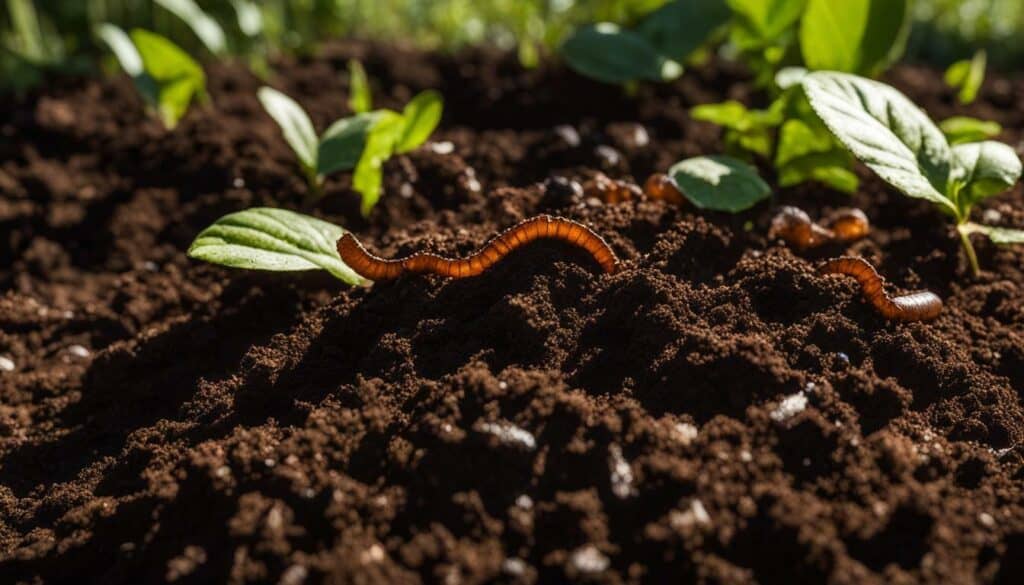
Remember, the key to a successful potting soil mix is balance. It should be well-draining yet retain enough moisture to keep your plants hydrated. It should also provide nutrients for healthy growth without being over-fertilized. By understanding the essential ingredients and their roles, you can create the perfect potting soil mix for your gardening needs.
| Ingredient | Role |
|---|---|
| Sphagnum Peat Moss | Moisture retention, light texture |
| Coconut Coir | Moisture retention, root growth promotion |
| Perlite | Improved drainage, prevents soil compaction |
| Vermiculite | Moisture retention, improved aeration |
| Compost | Organic matter, nutrient enrichment |
| Granular Fertilizers | Slow-release nutrients |
Creating Your Own Potting Soil Mix
Don’t want to rely on store-bought potting soil? Creating your own mix is a cost-effective and customizable option for beginner gardeners. By understanding the key ingredients and ratios, you can tailor the soil to meet the specific needs of your plants. Here’s a simple guide to help you get started:
- Step 1: Choose a Base
The base of your potting soil mix provides structure and moisture retention. Peat moss and coconut coir are popular options. Peat moss is acidic and retains moisture well, while coconut coir has a neutral pH and excellent moisture-holding capacity.
- Step 2: Add a Lightweight Medium
Adding perlite or vermiculite to your mix improves drainage and aeration. Perlite is a volcanic glass that promotes water drainage and prevents compaction, while vermiculite retains moisture and improves nutrient absorption.
- Step 3: Incorporate Nutrient-Rich Compost
Compost is essential for providing nutrients to your plants. It enriches the soil with organic matter, improves soil structure, and fosters beneficial soil organisms. You can make your own compost using kitchen scraps, yard waste, and other organic materials or purchase it from a local supplier.
- Step 4: Enhance with Organic Amendments
To further boost the nutrient content of your potting soil mix, consider adding organic amendments like blood meal, bone meal, and ground limestone. Blood meal is high in nitrogen, bone meal is a good source of phosphorus, and ground limestone helps balance the pH level of acidic soils.
Experimenting with different ratios of these ingredients will allow you to fine-tune your potting soil mix according to the specific needs of your plants. Keep in mind that certain plants may require specific soil conditions, so it’s essential to research their preferences before creating your mix.
Remember, creating your own potting soil mix not only gives you control over the quality of soil but also helps you save money, especially if you have a large garden or enjoy frequent potting. So get your hands dirty, mix up a batch of your own potting soil, and watch your plants flourish!
| Ingredient | Role |
|---|---|
| Peat Moss/Coconut Coir | Provides structure and retains moisture |
| Perlite/Vermiculite | Improves drainage and aeration |
| Compost | Enriches soil with organic matter and nutrients |
| Blood Meal/Bone Meal | Supplies nitrogen and phosphorus |
| Ground Limestone | Helps balance soil pH |
Understanding Soil pH and Nutrient Availability
Soil pH plays a crucial role in determining the availability of essential nutrients for plants. Understanding and maintaining the right pH level is key to unlocking your soil’s potential. Different plants have different pH requirements, and maintaining the ideal pH range in your soil will ensure optimal nutrient uptake and overall plant health.

Testing the pH level of your soil is a simple process that can be done using a soil testing kit or by sending a sample to a laboratory for analysis. A pH level below 7 indicates acidic soil, while a pH level above 7 indicates alkaline soil. Most plants prefer slightly acidic to neutral soil, with a pH level between 6 and 7. If your soil’s pH level is too high or too low, you can adjust it by adding amendments such as lime to raise pH or sulfur to lower pH.
Ensuring Nutrient Availability
Aside from pH, nutrient availability is also influenced by soil composition and organic matter content. Organic matter, such as compost, aged manure, and leaf mold, improves soil structure and nutrient-holding capacity. It also fosters beneficial soil organisms, like earthworms, that aid in nutrient cycling and root development.
One way to ensure nutrient availability is by regularly adding organic matter to your soil. This can be done by incorporating compost into the top layer of soil or by using it as a mulch around plants. Compost releases essential nutrients slowly over time, providing a steady supply of food for your plants.
In addition to organic matter, you can also supplement your soil with specific nutrients through the use of organic or synthetic fertilizers. These fertilizers can be applied according to the specific nutrient deficiencies identified in your soil test results.
By understanding soil pH and nutrient availability, you can make informed decisions about how to improve your soil and provide the best growing conditions for your plants. Unlocking the potential of your soil is essential for gardening success, whether you’re a beginner or an experienced gardener.
Improving Soil Quality
Healthy soil equals healthy plants. In this section, we’ll explore some practical ways to improve your soil’s quality and create an ideal environment for plant growth.
One effective method of improving soil quality is by adding organic matter. Organic matter, such as compost, aged manure, and leaf mold, enriches the soil by providing essential nutrients. It also improves soil structure, allowing for better drainage and aeration. Adding organic matter encourages the growth of beneficial soil organisms, such as earthworms, which help break down organic matter and create nutrient-rich soil.
Another important factor in improving soil quality is minimizing the use of pesticides. While pesticides can be effective in controlling pests, they can also harm beneficial soil organisms. These organisms, such as bacteria and fungi, play a crucial role in maintaining soil health and nutrient cycling. By reducing pesticide use, you allow these organisms to thrive and contribute to a more balanced and vibrant soil ecosystem.
Lastly, it is essential to allow the soil to dry before planting. Working with wet soil can lead to compaction, which restricts root growth and limits the movement of air and water. Before planting, ensure that your soil is properly drained and has reached an appropriate moisture level. This will create a favorable environment for roots to establish and allow for optimal nutrient absorption.
Summary:
- Add organic matter, such as compost and aged manure, to improve soil quality and nutrient content.
- Minimize the use of pesticides to preserve beneficial soil organisms.
- Allow the soil to dry before planting to prevent compaction and promote healthy root growth.
By following these practices, you can improve your soil’s quality and create an optimal environment for your plants to thrive. Remember, healthy soil is the foundation of a successful garden!
| Benefit | Method |
|---|---|
| Enrich soil with nutrients | Add organic matter, such as compost and aged manure |
| Improve soil structure | Enhance drainage and aeration with organic matter |
| Promote beneficial soil organisms | Minimize pesticide use |
| Prevent compaction and promote root growth | Allow soil to dry before planting |
Understanding Different Soil Types
Not all soil is created equal. Understanding the different soil types in your garden will help you tailor your gardening practices to maximize plant growth. Whether you have clay, sandy, or loamy soil, each type has its own characteristics and requires specific care to create the ideal growing conditions for your plants.
Clay Soil
Clay soil is known for its ability to retain moisture, making it a good choice for gardens in areas with dry climates. However, clay soil can be heavy and dense, which means it drains poorly and can become compacted easily. To improve clay soil, add organic matter like compost or aged manure to increase its fertility and drainage. Additionally, avoid overwatering to prevent waterlogging, as excess moisture can lead to root rot and other plant diseases.
Sandy Soil
Sandy soil, on the other hand, drains quickly and is often low in nutrients. It feels gritty to the touch and tends to dry out faster than other soil types. To improve sandy soil, incorporate organic matter such as compost or peat moss to increase its ability to retain moisture and nutrients. Regularly adding mulch can also help to conserve moisture and reduce evaporation in sandy soil.
Loamy Soil
Loamy soil is often described as the ideal soil type for gardening. It has a balanced texture that allows for good drainage while retaining enough moisture for plants. Loamy soil is rich in organic matter, making it fertile and nutrient-rich. To maintain the quality of loamy soil, regularly add compost or organic matter to replenish nutrients and promote healthy plant growth.
| Soil Type | Texture | Drainage | Nutrient Content |
|---|---|---|---|
| Clay Soil | Heavy and dense | Poor | High |
| Sandy Soil | Gritty | Fast | Low |
| Loamy Soil | Balanced | Good | High |
By understanding the characteristics of different soil types and taking the necessary steps to improve their quality, you can create a garden that thrives. Remember to test the pH level of the soil and consider its nutrient content to choose the appropriate plants for each soil type. Adding organic matter, such as compost, aged manure, and leaf mold, can improve soil quality by providing essential nutrients, improving drainage, and fostering beneficial soil organisms. With the right knowledge and care, you can unlock the full potential of your soil and watch your garden flourish.

Adding Organic Matter for Soil Improvement
Adding organic matter is a tried and true method for improving soil quality and providing the nutrients needed for robust plant growth. Organic matter, such as compost, aged manure, and leaf mold, enriches the soil by enhancing its structure, improving drainage, and fostering beneficial soil organisms.
Compost, often referred to as “black gold,” is a valuable addition to any garden. It is created by decomposing organic waste, such as kitchen scraps, yard trimmings, and leaves. This nutrient-rich material adds essential nutrients to the soil, including nitrogen, phosphorus, and potassium. Compost also improves soil texture, helping clay soils drain better and sandy soils retain moisture.
Table: Common Organic Matter for Soil Improvement
| Organic Matter | Benefits |
|---|---|
| Compost | Improves soil structure and fertility |
| Aged Manure | Provides slow-release nutrients |
| Leaf Mold | Enhances soil moisture retention |
Another organic matter option is aged manure, which is rich in nutrients like nitrogen, phosphorus, and potassium. It releases these nutrients slowly, providing a steady supply to plants over time. When using manure, ensure it is well-aged, as fresh manure can burn plants due to its high ammonia content. It’s best to source manure from herbivores like cows, horses, or chickens.
Leaf mold, as the name suggests, is created by decomposing leaves. This organic matter improves soil moisture retention, making it particularly beneficial for sandy soils that dry out quickly. It also adds trace minerals and micronutrients to the soil, promoting overall plant health.
When adding organic matter to your soil, aim for a ratio of 1:1, mixing equal parts organic matter and existing soil. Spread the organic matter in a layer about 2-3 inches thick and work it into the top 6-8 inches of soil. This process can be done in both existing gardens and raised beds.
By incorporating organic matter into your soil, you’ll create a nutrient-rich environment that supports healthy plant growth. Remember to choose organic matter that suits your specific soil type and gardening needs, and watch your garden thrive!

Considering pH and Nutrient Content
Before selecting plants for your garden, it’s important to evaluate the pH and nutrient content of your soil to ensure optimal growing conditions. The pH level of your soil determines the availability of nutrients to your plants. Generally, a pH level between 6 and 7 is considered ideal for most garden plants. To test the pH level of your soil, you can use a home testing kit or send a soil sample to a lab for professional analysis.
Once you have determined the pH level of your soil, you can make adjustments to create a more favorable environment for your plants. If your soil is too acidic (pH below 6), you can raise the pH by adding agricultural lime. On the other hand, if your soil is too alkaline (pH above 7), you can lower the pH by incorporating elemental sulfur or organic materials like peat moss or pine needles.
Aside from pH, the nutrient content of your soil is crucial for plant growth. Most plants require a balanced combination of macronutrients (nitrogen, phosphorus, and potassium) and micronutrients (iron, zinc, magnesium, etc.) for healthy development. Conducting a soil test will provide you with valuable information about the nutrient levels in your soil. Based on the results, you can amend your soil with organic or synthetic fertilizers to provide the necessary nutrients for your plants.
Remember, maintaining proper pH and nutrient levels is an ongoing process. Regular soil testing and amendments will help you create an optimal growing environment for your plants and ensure their success.
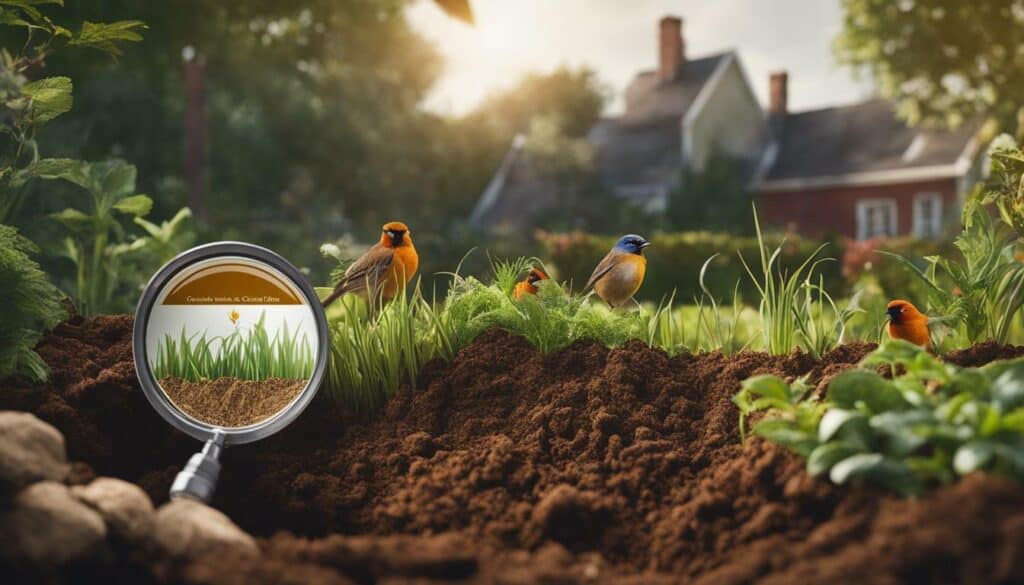
| Nutrient | Function |
|---|---|
| Nitrogen (N) | Stimulates leafy growth and overall plant development. |
| Phosphorus (P) | Promotes root development, flowering, and fruiting. |
| Potassium (K) | Aids in plant growth, disease resistance, and nutrient uptake. |
| Micronutrients | Essential for plant health, even though required in smaller quantities. |
“Understanding the pH and nutrient content of your soil is key to successful gardening. By providing the optimal conditions for your plants, you can enjoy a bountiful harvest and vibrant garden all season long.” – I
Conclusion
Congratulations! You’ve now gained essential knowledge about soil for beginners. Armed with this information, you can confidently embark on your gardening journey and turn your backyard into a thriving plant paradise.
Understanding soil is the key to successful gardening. Whether you’re starting with potted plants or creating a full-fledged garden, good soil is the foundation for healthy plant growth. The right potting soil provides the necessary nutrients, moisture, and drainage for seed germination and seedling growth. On the other hand, garden soil that is well cared for promotes lush and vibrant plants.
When choosing potting soil, look for qualities such as good drainage, a lightweight texture, and the ability to hold nutrients and moisture. Common ingredients in potting soil mixes include sphagnum peat moss, coconut coir, perlite, vermiculite, compost, and granular fertilizers. By understanding the basics of potting soil composition, you can create your own mix tailored to the needs of your plants.
Improving soil quality is essential for long-term gardening success. Adding organic matter like humus, compost, and aged manure can enrich the soil by providing essential nutrients, improving drainage, and fostering beneficial soil organisms. It’s also important to minimize the use of pesticides and allow the soil to dry before planting to create a healthy environment for your plants.
Finally, understanding the type of soil in your garden is crucial. Clay soil holds moisture but drains slowly, sandy soil drains quickly but lacks nutrients, and loamy soil provides the ideal balance for plant growth. Additionally, consider the soil’s pH level and nutrient content when choosing plants for your garden.
So go ahead, get your hands dirty and unlock the potential of your soil. With a little knowledge and care, you’ll be able to create a thriving garden that brings joy, beauty, and delicious harvests.
Why is Understanding Soil Important for Gardening Success?
Understanding soil is crucial for gardening success. It determines the health and productivity of plants. Knowing the composition, pH level, and nutrient content of the soil helps gardeners determine which plants will thrive in their specific garden space. By understanding how to utilize garden space efficiently, gardeners can create an ideal environment for plants to grow and flourish.
FAQ
Q: Why is soil important for gardening success?
A: Understanding soil is essential for gardening success because it provides the necessary nutrients and environment for plants to grow and thrive.
Q: What qualities should I look for in potting soil?
A: When choosing potting soil, it is important to look for qualities like good drainage, lightweight texture, and the ability to hold nutrients and moisture.
Q: What are the common ingredients in potting soil mixes?
A: Common ingredients in potting soil mixes include sphagnum peat moss, coconut coir, perlite, vermiculite, compost, and granular fertilizers.
Q: How can I create my own potting soil mix?
A: You can create your own potting soil mix by combining peat or coco coir with perlite or vermiculite. A complete potting soil mix would also include compost, blood meal, bone meal, and ground limestone.
Q: What is the ideal soil pH for plant growth?
A: The ideal soil pH for plant growth is between 6 and 7. It is important to test the pH level of the soil as it determines nutrient availability.
Q: How can I improve soil quality?
A: To improve soil quality, you can add organic matter like humus, minimize the use of pesticides, and allow the soil to dry before planting.
Q: What are the different types of soil?
A: The different types of soil include clay soil, which holds moisture but drains slowly, sandy soil, which drains quickly but lacks nutrients, and loamy soil, which is ideal for plant growth.
Q: How can I add organic matter to improve soil quality?
A: You can add organic matter like compost, aged manure, and leaf mold to improve soil quality by providing nutrients, improving drainage, and fostering beneficial soil organisms.

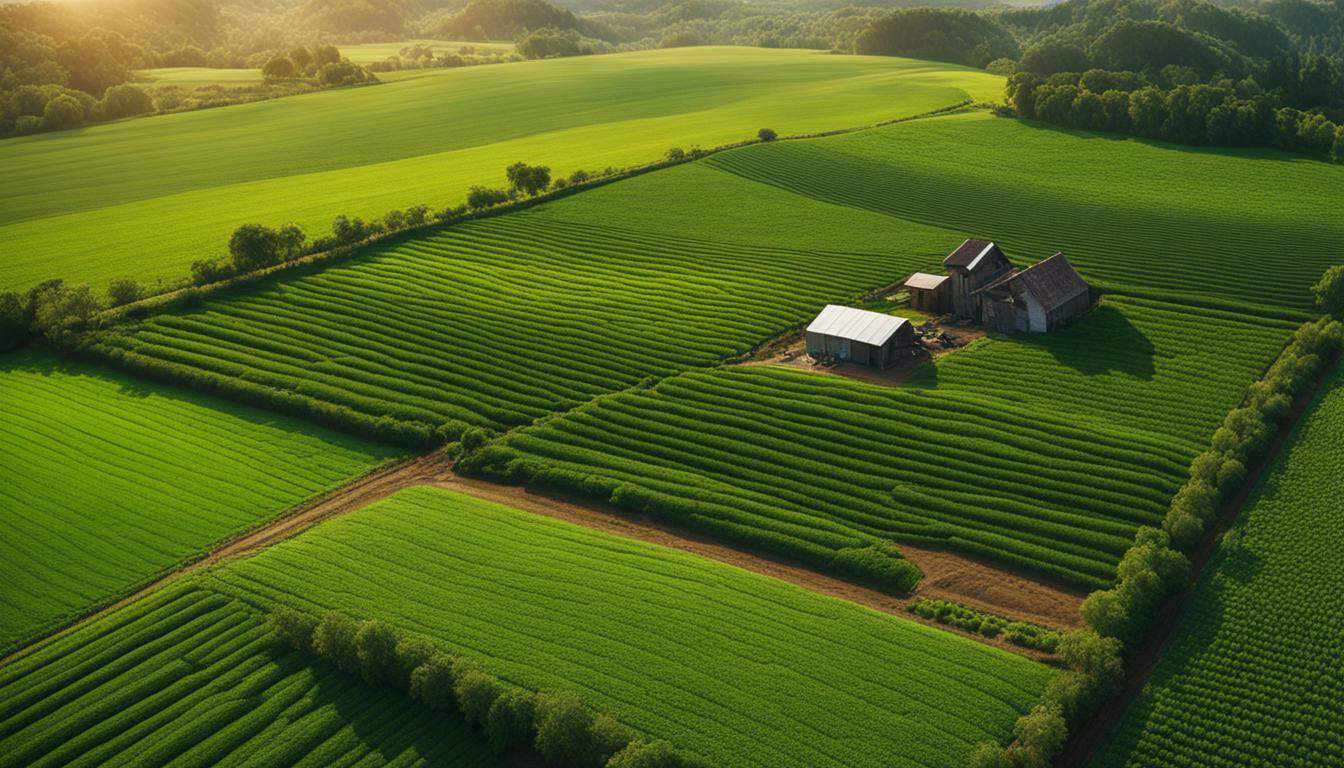



Leave a Reply